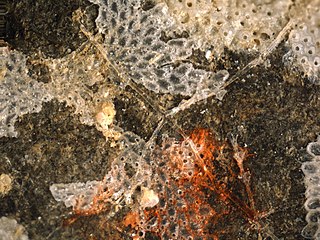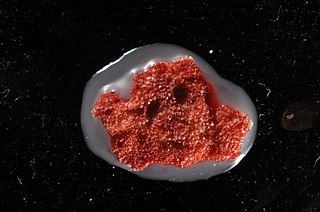
Stenaelurillus is a genus of jumping spiders that was first described by Eugène Louis Simon in 1886. Most species live in Africa, with some species found in Asia, including China. All species have two white longitudinal stripes on the carapace, and both sexes show strong bristles around the eyes. The name is a combination of the Greek sten- "narrow" and the salticid genus Aelurillus.

Hybotidae, the typical dance flies, are a family of true flies. They belong to the superfamily Empidoidea and were formerly included in the Empididae as a subfamily.

Atelestidae is a family of flies in the superfamily Empidoidea. The four genera were placed in a separate family in 1983; they were formerly either in Platypezidae or considered incertae sedis. While they are doubtless the most basal of the living Empidoidea, the monophyly of the family is not fully proven. The genus Nemedina seems to represent a most ancient lineage among the entire superfamily, while Meghyperus is probably not monophyletic in its present delimitation, and it is liable to be split up eventually, with some species being placed elsewhere. In 2010, the genus Alavesia, previously only known from Cretaceous fossils, was found alive in Namibia, subsequent species were also described from Brazil.

Schizoporella is a genus of bryozoans in the family Schizoporellidae.

Stenaelurillus guttatus, synonym Mashonarus guttatus, is a species of jumping spider in the genus Stenaelurillus that lives in Botswana, Zambia and Zimbabwe. It was first described in 2002 by Wanda Wesołowska and Meg S. Cumming. It was initially the type species for the genus Mashonarus but was moved to its current genus in 2018. The spider is medium-sized, with a cephalothorax that is between 2.1 and 2.7 mm long and 2.0 mm (0.079 in) and an abdomen that is between 2.3 and 3.8 mm long. It is very dark in colour, either dark brown or black, and has a distinctive pattern on its back consisting of two white stripes on the thorax and three sets of two white patches on the abdomen. This pattern gives the species its name, which is based on a Latin word that can be translated spotted. It lives in a wide range of environments, from dry to wet climates, and at altitudes between 500 and 1,500 m above sea level. First observed in a garden, the spider has been found under logs, stones and rocks, in leaf litter, and, after rains, on grass, shrubs and garden walls. It feeds on termites, particularly Odontotermes transvaalensis, and other prey including fruit flies and leafhoppers.

Stenaelurillus ignobilis is a species of jumping spider in the genus Stenaelurillus that lives in Zimbabwe. The female was first described in 2011 by Wanda Wesołowska and Meg Cumming. The male has yet to be described. The spider takes its name from a Latin word that can be translated unsightly. The spider is medium-sized, with a carapace 2.6 mm (0.10 in) long and abdomen 3.4 mm (0.13 in) long. The carapace is brown, covered in bristles and has an almost indiscernible stripe, while the abdomen is larger and has a stripe of lighter brown down the middle of its generally darker, nearly black. The long spinnerets are also hairy while the legs have both hairs and spines. It is similar to Stenaelurillus mirabilis but can be distinguished by the design of the epigyne, and particularly the way that the gonopores are hidden in deep cup-like depressions.

Fenestrulina is a genus within the bryozoan order Cheilostomatida. It is the only member of the family Fenestrulinidae. It has a world-wide distribution.

Beania magellanica is a species of colonial bryozoan in the family Beaniidae. It has a cosmopolitan distribution, occurring in shallow waters in the Atlantic and Pacific Oceans and in Antarctica.

Stenaelurillus pseudoguttatus is a species of jumping spider in the genus Stenaelurillus that lives in Namibia. The species was first described in 2018 by Dmitri Logunov and Galina Azarkina. The holotype had originally been described by Wanda Wesołowska and Meg S. Cumming in 2002 and allocated to the genus Mashonarus guttatus but was recognised as a new species 16 years later. Stenaelurillus pseudoguttatus takes its name from the fact that it had previously been named in the type series of this other species, now named Stenaelurillus guttatus. Only the male has been identified. The spider is medium-sized, with a carapace 2.28 mm (0.090 in) long and an abdomen 2.05 mm (0.081 in) long. The carapace is yellow-brown and has two white stripes, while the abdomen is a dark brown with six white spots. It can be distinguished from both Stenaelurillus brandbergensis and Stenaelurillus guttatus by its long sword-like embolus.
Beania is a genus of bryozoans belonging to the family Beaniidae.
Lanceoporidae is a family of bryozoans belonging to the order Cheilostomatida.
Stomatoporidae is a family of bryozoans belonging to the order Cyclostomatida.

Celleporina is a genus of bryozoans belonging to the family Celleporidae.
Antarctothoa is a genus of bryozoans belonging to the family Hippothoidae.
Escharella is a genus of bryozoans belonging to the family Escharellidae.
Hippoporella is a genus of bryozoans belonging to the family Hippoporidridae.
Hippothoa is a genus of bryozoans belonging to the family Hippothoidae.
Parasmittina is a genus of bryozoans belonging to the family Smittinidae.

Rhynchozoon is a genus of bryozoans belonging to the family Phidoloporidae.
Smittina is a genus of bryozoans belonging to the family Smittinidae.










